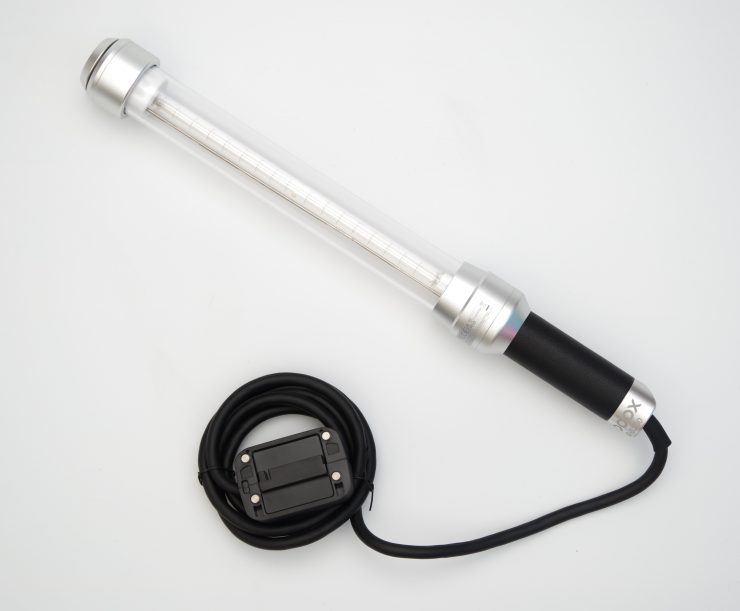In this review I test the Godox AD-S200 stick flash head for the AD200/AD200Pro.
Godox’s AD200 started as a power unit and flash head, but quickly expanded into a system all of its own. The AD200/AD200Pro (we will refer to the AD200 for brevity) is at its core a power and control unit, packing the battery, LCD screen and buttons, and radio receiver compatible with Godox’s X protocol. The unit ships with a rectangular Fresnel head, looking like most speedlight heads on the market, and a bare bulb. Godox quickly released an optional round head (like that of the V1 flash), and afterwards the R200 ring light, along with extension cables and other accessories.

To further flesh out this growing system, Godox released in September 2023 the AD-S200 stick flash head. Let’s take a look.
Physical Description

The AD-S200 ships in a soft case, typical for Godox. This rectangular case is well padded, the zippers move smoothy, and handles make it easy to carry.

Inside the case is the AD-S200 itself, along with a set of barn door modifiers.

The AD-S200 is 65 cm long. The flash tube itself is 4cm thick and 26cm long. Below the flash tube is a handle. The stick weights 1.1 kg this is including the cable, AD200 connector and barndoors; the stick itself is lighter and easy to handle.


Both ends of the stick feature a 1/4-20 hole, same as the tripod mount on a camera. This opens many options to mount the stick on tripods or other supports.

The handle is comfortable and makes hand-holding easy.
Below the handle is the thick but flexible cable connecting the stick to the AD200 module. Contrary to the R200 ring light, the AD-S200 does not come with a case to carry the AD200 module when on the move. This is acceptable: while the R200 is intended to be mounted on the camera, and move around with the photographer, the AD-S200 will, most of the time, remain in one place, or be carried by an assistant.

The stick ships with a clip-on set of barn doors. It is nice that this is included and not an optional purchase. The barn doors clip directly on the shaft of the stick. Attachment is straightforward but the clamps are very stiff. I had to be careful because I feared damaging the glass by being careless. Removal is easier.

The barn doors are made of a shiny metallic casing, redirecting light forward. They provide, essentially, a 180° illumination instead of the 360° that the stick produces by default. Attached to the casing are the two doors, painted black and adjustable. They can be fully opened, fully closed, or any step in between. Friction is good enough that the doors remain in place one set.
In Use
The AD-S200 produces 360° illumination. This is vastly different from a regular studio light, which only directs light forward. As such, even though the AD-S200 provides the same 200W of power as other AD200 heads, this power is spread all around, decreasing the amount of light directly reaching the subject. Exposure settings will thus need to be adjusted.

There are two benefits to the tube shape. The first is that the light source is larger than usual, even without modifiers, making it less harsh and directional. The second is that throwing light all around bounces it over numerous surfaces, creating a softer spill on the subject (as long as bounce surfaces are not too far away!). This also has the benefit of lighting up a room more evenly, a useful feature if the photographer needs to move around through a crowd.
The flash provides the same 5600K light temperature as other flash heads, letting it integrate easily within more complex lighting schemes.
There is no substitute for actual testing and comparisons when discussing a new light source. To test, we used a subject located 1 meter in front of a uniform background, 1.5 meters in front of the camera. Light sources were placed at 1.5 meters camera left, just above the camera. We used the AD200Pro’s round head as a baseline. The AD-S200 is oriented vertically except when mentioned otherwise. You can click on images to see a larger version.






The first takeaway is that the AD-S200 needs to have its power adjusted two stops higher than the round head. This isn’t surprising as light is thrown all around instead of only forward.
A second takeaway is that light spill on the subject is different with the AD-S200, but not overwhelmingly so. The flash is longer but not truly wider, so there is a limit to the differences. Shadows and ambient illumination are impacted more strongly than the subject itself.
Using the barn doors has a visible impact on the results. Simply attaching the accessory increases the amount of light directed towards the subject, even with the doors wide open. It also increases the effective width of the stick, improving the spread. Closing the doors partially lets the photographer shape the light with fine control.
Moving the stick higher up and placing it horizontally has a much more significant impact on the end result, creating a softer overall illumination.
These results highlight that the AD-S200 can indeed deliver results which are different from those produced by a regular flash. Positioning of the stick is key, has it has a dramatic impact on the output. Even without modifiers, the AD-S200 can shape the light in ways more varied than a regular flash.
Other Options
There is no exact alternative to the AD-S200 on the market. The huge majority of light sticks or wands are continuous, LED-based lights. Such wands are useful, and can often change their RGB output, but they do not come close to packing the same power as the AD-S200.
In fact, the closest equivalent to this stick light is probably a regular flash contained inside a small rectangular softbox. Even then, the output won’t be similar, since softboxes are highly directional. In other words, it is hard to imagine a single light source producing the same output as the AD-S200. As such, with its 200W of power and $339 price tag, the AD-S200 is a moderately expensive and rather unique addition to the AD200/AD200Pro system.
The AD-S200 can be purchased via Amazon, of course, but also B&H Photo, Adorama under the Flashpoint brand name, and many of your other favorite photography stores.



